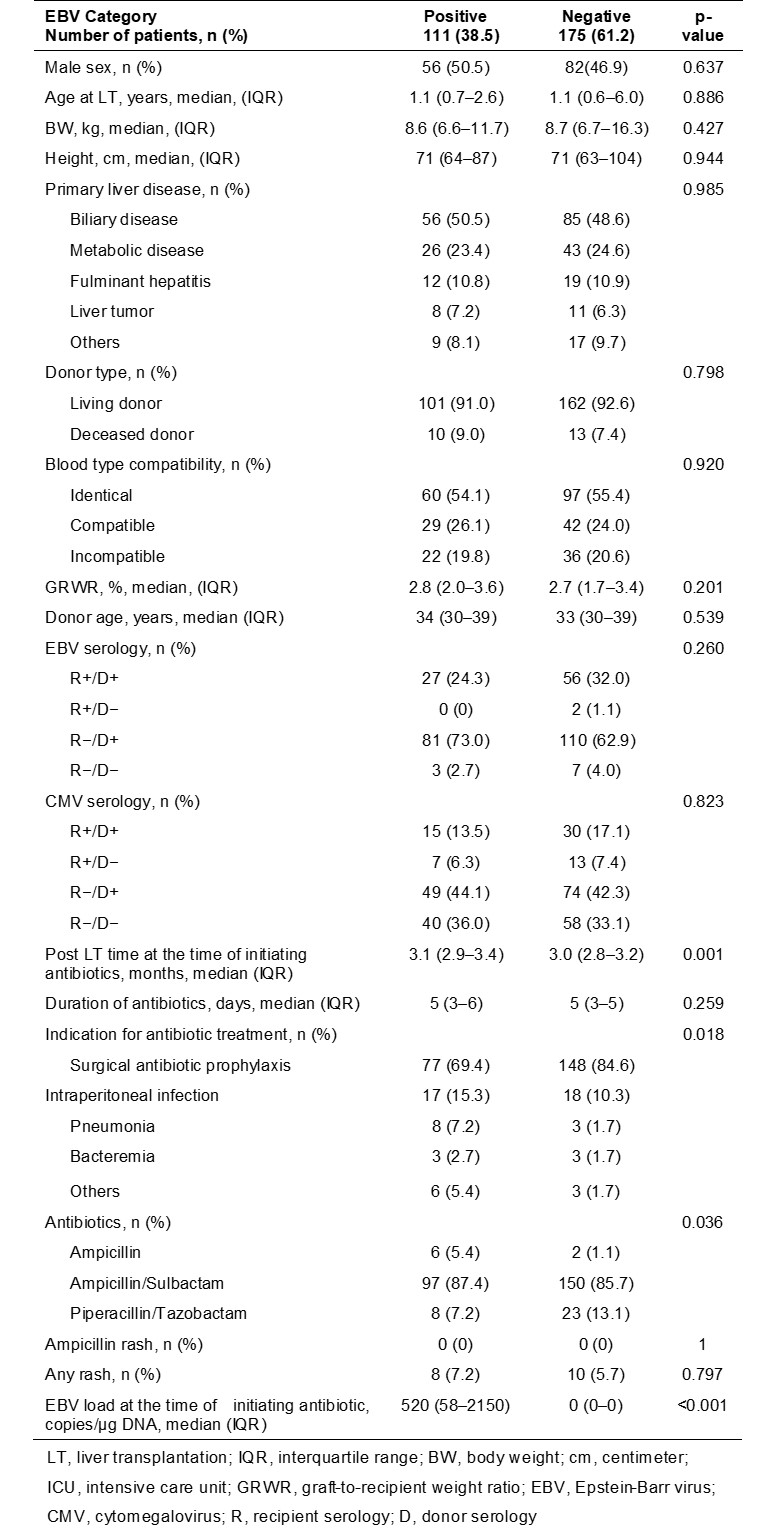Ampicillin rash does not occur among pediatric liver transplant recipients even in the presence of EBV DNAemia
Yusuke Tokuda1,2, Masaki Yamada2,3, Akinari Fukuda4, Kensuke Shoji3, Seisuke Sakamoto4, Akira Ishiguro1, Ken-Ichi Imadome2, Mureo Kasahara4.
1Center for Postgraduate Education and Training, National Center for Child Health and Development, Tokyo, Japan; 2Department of Advanced Medicine for Viral Infections, National Center for Child Health and Development, Tokyo, Japan; 3Division of Infectious Diseases, Department of Medical Subspecialties, National Center for Child Health and Development, Tokyo, Japan; 4Organ Transplantation Center, National Center for Child Health and Development, Tokyo, Japan
Introduction: Epstein-Barr virus (EBV) infection frequently develops among children undergoing liver transplantation (LT) due to mandated immunosuppressive therapy. Penicillin derivatives are contraindicated in patients with EBV-associated infectious mononucleosis because of ampicillin rash. Hence, the administration of penicillin derivatives may be avoided in patients with high EBV load. However, the risk of administering penicillin derivatives in pediatric LT recipients with EBV infection remains unknown. Therefore, we investigated the incidence of ampicillin rash among pediatric LT recipients with or without the presence of concurrent EBV infection.
Methods: A retrospective study was conducted at the largest pediatric transplant center in Japan. We investigated all the pediatric LT recipients who received penicillin derivatives within two years after LT between 2014 and 2020. We separated the cohort into EBV positive and negative groups to assess the incidence of ampicillin rash. The ampicillin rash was defined as the cutaneous lesions of maculopapular and pruritic and involving the trunk, face, and extremities that occurred within two weeks after the initiation of the penicillin derivatives.
Results: Two hundred eighty-six LT recipients were enrolled. The EBV-positive group was 111 (38.5%), and the EBV-negative group was 175 (61.5%). No patients developed ampicillin rash in both group.

Conclusion: In this study, ampicillin rash was not seen. Penicillin derivatives can be used safely even among pediatric LT recipients with EBV infection.
[1] Luzuriaga K, Sullivan JL. Infectious mononucleosis. N Engl J Med. 2010;362:1993-2000.
[2] Patel BM. Skin rash with infectious mononucleosis and ampicillin. Pediatrics. 1967;40:910-1.
[3] Pullen H, Wright N, Murdoch JM. Hypersensitivity reactions to antibacterial drugs in infectious mononucleosis. Lancet. 1967;2:1176-8.
[4] Rozieres A, Vocanson M, Rodet K, et al. CD8+ T cells mediate skin allergy to amoxicillin in a mouse model. Allergy. 2010;65:996-1003.
[5] Saito-Katsuragi M, Asada H, Yokoi S, Niizeki H, Miyagawa S. Ampicillin-induced cutaneous eruption associated with Epstein-Barr virus reactivation. J Am Acad Dermatol. 2005;52:127-8.
[6] Anci E, Braun C, Marinosci A, et al. Viral Infections and Cutaneous Drug-Related Eruptions. Front Pharmacol. 2020;11:586407.
[7] Chovel-Sella A, Ben Tov A, Lahav E, et al. Incidence of Rash After Amoxicillin Treatment in Children With Infectious Mononucleosis. Pediatrics. 2013;131:e1424-e1427.
[8] Hocqueloux L, Guinard J, Buret J, Causse X, Guigon A. Do penicillins really increase the frequency of a rash when given during Epstein-Barr Virus primary infection? Clin Infect Dis. 2013;57:1661-2.
[9] Dibek Misirlioglu E, Guvenir H, Ozkaya Parlakay A, et al. Incidence of Antibiotic-Related Rash in Children with Epstein-Barr Virus Infection and Evaluation of the Frequency of Confirmed Antibiotic Hypersensitivity. Int Arch Allergy Immunol. 2018;176:33-38.